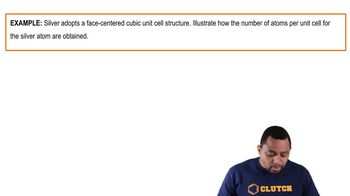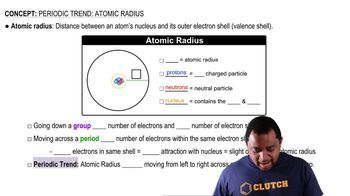Consider the unit cells shown here for three different structures that are commonly observed for metallic elements. (a) Which structure(s) corresponds to the densest packing of atoms?
Iridium crystallizes in a face-centered cubic unit cell that has an edge length of 3.833 Å. (a) Calculate the atomic radius of an iridium atom. (b) Calculate the density of iridium metal.
 Verified step by step guidance
Verified step by step guidanceKey Concepts
Face-Centered Cubic (FCC) Structure

Atomic Radius

Density Calculation

Consider the unit cells shown here for three different structures that are commonly observed for metallic elements. (b) Which structure(s) corresponds to the least dense packing of atoms?
Sodium metal (atomic weight 22.99 g/mol) adopts a body-centered cubic structure with a density of 0.97 g/cm3. (a) Use this information and Avogadro’s number (NA = 6.022 × 1023/mol) to estimate the atomic radius of sodium. (b) If sodium didn't react so vigorously, it could float on water. Use the answer from part (a) to estimate the density of Na if its structure were that of a cubic close-packed metal. Would it still float on water?
Calcium crystallizes in a body-centered cubic structure at 467°C. (a) How many Ca atoms are contained in each unit cell?
Calcium crystallizes in a face-centered cubic unit cell at room temperature that has an edge length of 5.588 Å.
a. Calculate the atomic radius of a calcium atom.
b. Calculate the density of Ca metal at this temperature.
